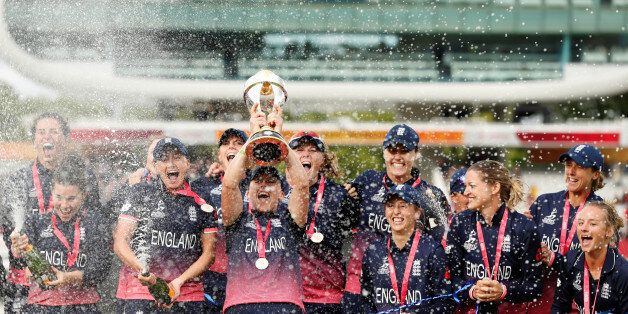
This summer's TV schedule offers an embarrassment of riches when it comes to sport - The ICC Cricket World Cup, the Rugby World Cup and UEFA Euro 2017. Remarkably, England have a chance to win them all.
Picture the start of Euro 2017: a wall of trophies, radio commentary, mugs of tea, fans in jerseys leave for the ground, pints are pulled, burgers fried, families on the edge of their sofas. Icons of British football - but not the men's game, it's the women's Euros on Channel 4. The twist is we are still not used to associating English football fandom with women's competitions. The opening sequence to the match ends on a cheeky, confident note: 'Watch a team that might win'.
Ten years ago we took a close look at the media coverage of men's and women's international football and it is safe to say, we have come a long way. When we compared a Women's World Cup match in 2007 to the men's Euro Qualifiers shown around the same time, the difference was stark - the production of the men's game was slick and dramatic, with experienced commentators and presenters, relaxed in front of the camera. It was easy to watch, and relate to the banter between Gary Lineker, Ian Wright and other familiar pundits.
By contrast, the staging for the women's match was less polished, the opening sequence was strangely imbued with pink and turquoise flowers and butterflies, and the presenters seemed ill at ease. Ten years later, Ian Wright is a pundit for the women's game. He joins Clare Balding, Michael Owen and experienced female players such as Eni Aluko and World Cup winner Heather Reilly. The commentators and pundits are confident with in-depth knowledge of individual players and teams.
In ten years women's football coverage has been transformed. What happened?
It's not been plain sailing. Years of petitioning, strategising and imagining in all aspects of the sport have led to small successes and increasing visibility. Fans, players, parents and the FA women's committee have demanded change. It's still hard to believe that a repeat episode of Porridge was scheduled to be aired instead of showing an England women's World Cup 2011 quarterfinal match on a main BBC channel. Public outrage demanded a U-turn and the match was finally aired on BBC2. London 2012 showed that the public had an appetite for women's football with record crowds at Wembley watching Great Britain defeat Brazil. England's women footballers finally played in the national stadium in 2014, selling all available tickets.
There are more opportunities than ever for girls and women to play the national sport to a high standard. Girls and boys are now allowed to play on the same team and same FA pitches, up to U18. Achieving this involved six incremental changes to national policy, eight years of research and grassroots activism. There is an expanded Women's Super League, a National Football Centre, and recently, the FA announced plans to develop eight new women's High Performance Football Centres. With these changes came international success. The women's team finished third in the last World Cup and are considered one of the top teams in the world. As Heather Reilly said before the match with Spain, 'the days of [England] playing the underdog card are over'.
These changes in policies and practices coincide with changes in how we see women who play sport. Once inconceivable, it is no longer unusual for a sportswoman to be a national hero. Jodie Taylor's hat trick in England's opening match of the Euros was dubbed the first by an English player since Lineker in 1986 and the third all time. The tactics of the Austrian coach were compared with those of Tottenham in the English Premier League. Commentary now focuses on technique, skill and strategy. The marking of gender, often used to diminish the women's game, is receding to be replaced by a focus on football and footballers.
This is the summer of women's sport, or should we finally just say sport?